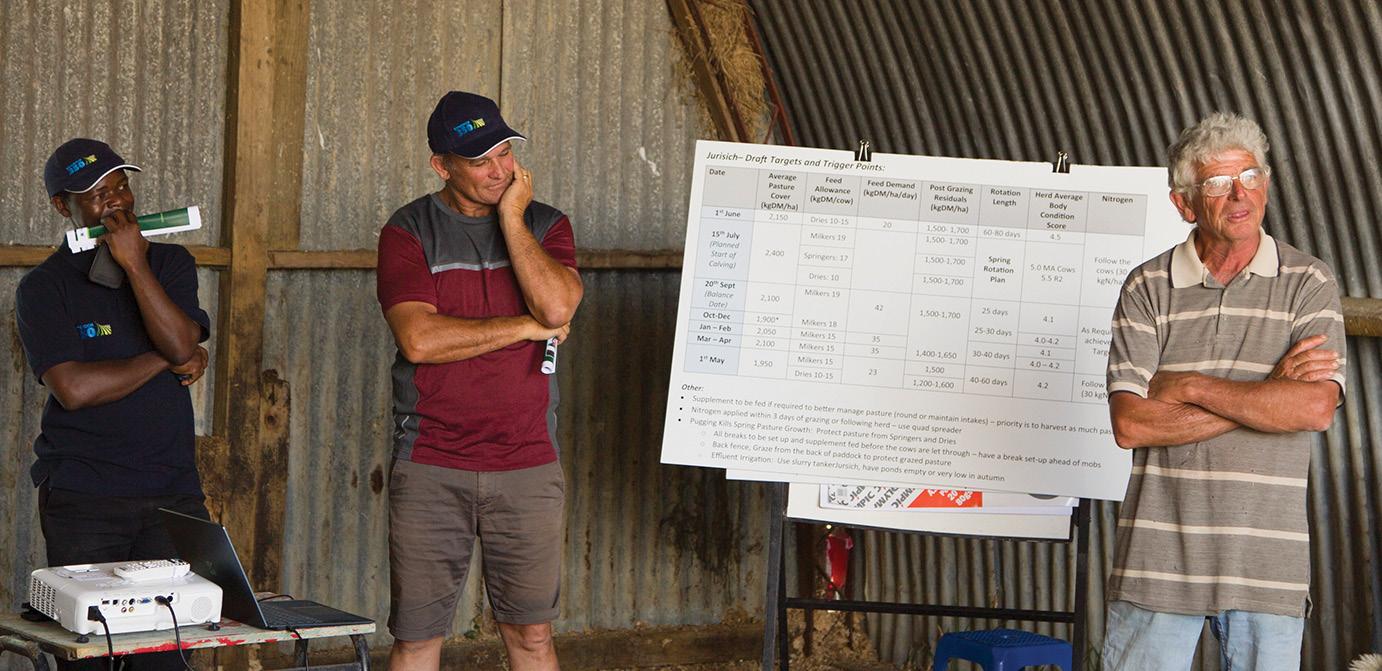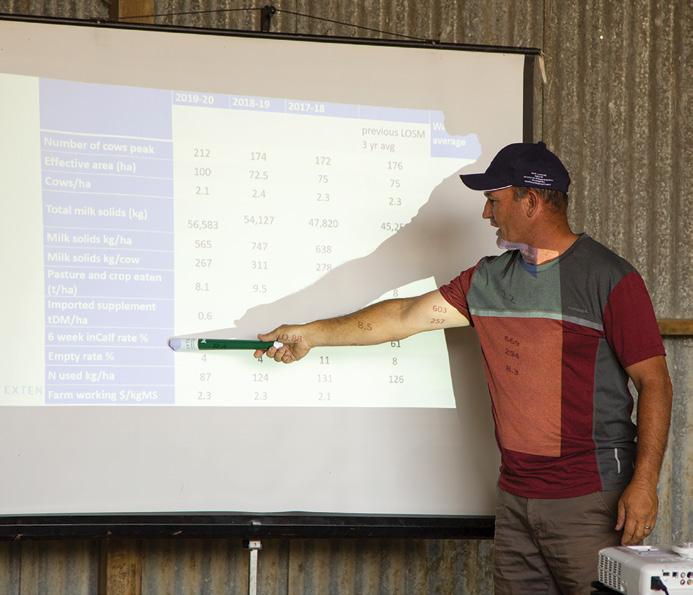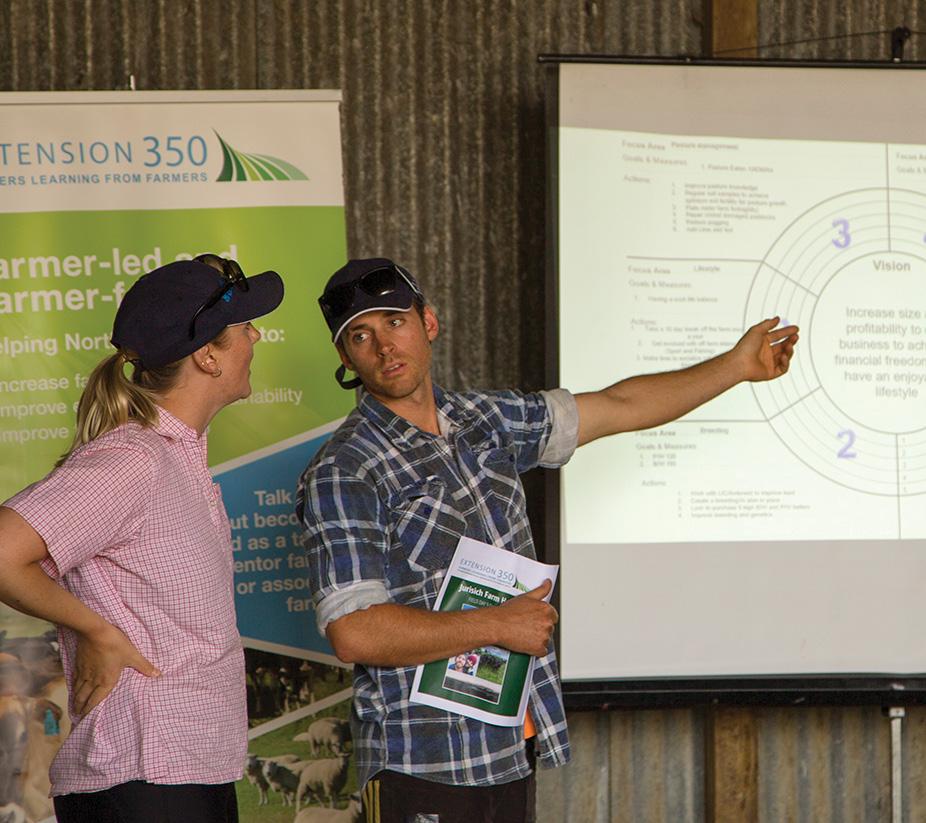
7 minute read
E350 Farming’s new generation leaders
SYSTEMS E350
Farming’s new generation leaders
A team of young Northland farmers have shown off the results of their experience with the E350 project. Chris Neill reports.
Northland’s Extension 350 project attracted young and old to its first dairy cluster when it started in June 2017. The experience of these four farmers in the project ended in May 2020 amid the legacy of drought and Covid-19.
At a December field day, with admissions of initial reluctance and scepticism, Graham and Kylie Beatty, Peter and Sue Skelton, Lachie McLean and Leroy and Kirsty Jurisich noted achievements of goals they thought aspirational and the critical importance of consistently completing the basics.
They all recognised the contribution of their mentors and the management team that supported them to make and sustain change - their team of trusted advisers who will hopefully remain connected beyond the project.
Leroy and Kirsty Jurisich with their recently-born son Jack hosted the day and shared greater detail on their experience and outcomes.
Their farmer mentor Danny Woodcock, farm consultant Tafi Manjala and product specialist Corey Thorn were in their management team that has supported the success story.
Leroy and Kirsty were keen and active from the very start, consistently delivering on the actions they had agreed with the management team to complete.
This in turn fuelled the enthusiasm of the management team to help Leroy and Kirsty push harder and faster toward achieving their vision and goals.
Danny kept encouraging them to focus on the long-term things that can make a
The faces of Northland’s dairy farming future: Leroy, Kirsty and Jack Jurisich.
Danny kept encouraging them to focus on the longterm things that can make a difference to achieving their goals and to minimise those day to day activities that can limit the ability of the land to produce.
difference to achieving their goals and to minimise those day to day activities that can limit the ability of the land to produce.
Their vision and goals as 50:50 sharemilkers were laid out in their planning wheel. It recognised the key areas of focus as (i) purchasing land, (ii) lifting pasture eaten to 10 tonnes drymatter (DM)/ha, (iii) producing 70,000kg milksolids (MS) with a once-a-day herd, (iv) meeting the farm’s environmental compliance requirements, (v) lifting P/W and B/W, and (vi) having a good work / life balance.
Leroy and Kirsty have achieved a compounding equity growth of 31% per year since 2007. In the three years of the project there has been near to $400,000 gain, including acquisition of the land they identified in their goals.

Top: Leroy describing the additional land they have added to the platform. Above: Lachie McLean describing the highlights of his journey as an E350 target farmer.

Production has lifted from 45,254kg MS in the year prior to the project to 56,583kg MS in their final year, which was challenged by the transition to OAD, drought, floods and introducing the additional land into their business.
Leroy and Kirsty are confident that with these challenges behind them they will be able to lift cow numbers and normalise their business to achieve their 70,000kg MS target.
Farm working expenses are $1.90/kg MS compared to a Northland sharemilker average of $2.70 and they intend to maintain the business at a level they can operate themselves without permanent labour. They see diversification to include beef alongside dairy as part of their business growth.
A key to low farm working expenses is the increase in pasture eaten which has been lifted from 8t/ha prior to E350 and reaching 9.5t/ha in 2018/19 before hitting the challenges of 2019/20.
The spring rotation planner has been a key tool, combined with a close focus on pasture measurement, recording in the feed wedge and management to utilise pasture as well as possible.
Annual nitrogen use is typically 120kg/
FARM FACTS:
50:50 Sharemilkers: Leroy and Kirsty Jurisich Owners: Peter and Val Nelson Location: Waiotira, south west of Whangarei Farm: 100ha milking platform Herd: Currently 212 Kiwicross cows, will increase to a maximum of 250 Production: Targeting 70,000kg MS Milking frequency: TAD to capture peak milk then OAD Calves: 12 week mating with 4 weeks AB Nitrogen: Up to 130kg N/ha/year
ha and only applied when conditions are likely to give a response.
Summer crops and silage help transfer feed across the season and palm kernel of 0.6t/ha is primarily used as a backup to pasture. The target of 10 t/ha pasture looks readily achievable and a key driver of profit.
Northland Regional Council are part funders of E350 and their environmental team were highly supportive of completing Farm Environment Plans for the target farms.
This helped identify the critical areas around effluent, waterway and land
management. For Leroy and Kirsty this has allowed them to understand what is required and when so they can schedule work and cost. They are intent on staying ahead of the game with current and future regulatory and market expectations.
The initial plan to increase P/W and B/W was to buy high BI cows as replacements. Instead, they focused on improving reproduction rate and using AI to achieve their gains.
Achieving body condition score targets at calving has improved the 6 week-in-calf rate from 61% to 84% over three years. A focus on achieving growth rate targets for young stock is another key success, contributing to a higher in-calf rate and ability to bring greater selection pressure on the herd.
The value of these changes is calculated to be worth $24,800 over the past three years.
Kirsty and Leroy have a clear focus on the business giving them the life they want. They are committed to OAD farming and have enjoyed showing Danny, a dedicated TAD farmer, how well it works for them.
Planning is a great means to ensure focus is maintained on the critical issues and the basics are attended to.
Their Targets and Trigger Points chart simply and clearly lays out the critical elements of what must be achieved and when. This allows them to be proactive rather than reactive, constantly working to a plan that is manageable.
With planning, scheduled time away from the farm for recreation and relaxation is reality.
Leroy identifies his three top tips for success which all relate to getting the basics right. (i) regularly monitoring body condition score to ensure cows are in a condition appropriate to their annual cycle, (ii) setting goals with the Planning Wheel and regularly checking in on progress as a reminder of what needs to be done and to recognise the achievements that have been made, (iii) measuring pasture to ensure the most cost effective quality and quantity of feed is available when required.
He recognises that getting people you trust involved in their business is a great help to achieving goals and anticipates that without the regular encouragement of the E350 team he will need to keep himself
The OAD herd taking advantage of shade.

Danny Woodcock describing the benefits of Leroy and Kirsty’s success in improving their six-week in-calf rate. The faces of Northland’s dairy farming future.


motivated, with encouragement from Kirsty. E350 connects a group of associate farmers with each target farm. Brad and Jess, Dave, Ben, Joel and Campbell have maintained close contact with Leroy and Kirsty as they have worked through their three years in the project. Farmers learning from farmers is a key element of the project.
The associate team have taken advantage of Leroy and Kirsty’s experience and identify their key learning as; (i) writing down your goals and sticking to them, (ii) pasture management and feed budgeting are critical to success, (iii) it takes hard work to make the change and get the good outcomes, (iv) Leroy and Kirsty are a real example of how a young couple can apply themselves to achieve their goals.
Danny Woodcock believes the “knowledge is in the room”, it’s a matter of avoiding distractions, doing the basics right and surrounding yourself with the right people.
The E350 target farmers all have stories that endorse this message.










